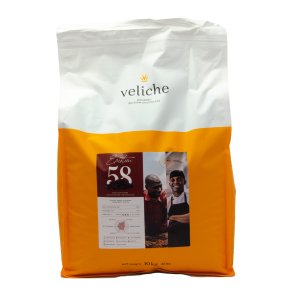Does compound chocolate leave you confounded? Are you curious about couverture chocolate? What IS the difference between them anyway? Chocolate is chocolate right? Well, no, not really...Read on to find out the differences between them both, which is better to use in particular situations and exactly what tempering is and why it's important.
Ah chocolate! We have a lot to thank the ancient civilisations of Central America for, along with the European chocolatiers in the 19th and 20th centuries who invented new methods and machines which then made it into the delicious treat that it is today.
You can read more on the fascinating history of chocolate here.
Not here for the history? Well, let's delve straight in...
Chocolate is essentially a mixture of cocoa solids mixed with fat, sugar and milk powders. Cocoa solids give chocolate its flavour. The different ratios of these ingredients changes whether the chocolate is dark, milk or white chocolate. The higher the cocoa solids in the chocolate, the darker and more chocolate-y it will be. White chocolate has no cocoa solids in it and some even argue that this means it's not chocolate at all!
Within all this, you then have two types of chocolate: Couverture and compound.
Couverture chocolate is high quality chocolate that uses cocoa butter as its fat source. Cocoa butter is part of the cocoa bean. It melts at body temperature and is what gives the chocolate a rich and melting mouthfeel.
Compound chocolate uses mostly, if not all, vegetable fats as its fat source. Vegetable fats have a higher melting point than cocoa butter, so it doesn't melt as readily. This is helpful in warmer weather!
Couverture chocolate is just plain delicious! Due to the cocoa butter content, it's luxurious and melts readily when you bite into it. It is more expensive than compound chocolate however, and this can be a barrier to using it. The other thing about couverture chocolate is that you cannot just melt it and pour it into a mould, as it won't set properly. It requires a process called "tempering" to get the chocolate to set properly again. Tempering is where you change the chocolate's temperature in a particular way as you are melting it.
Coverture chocolate, once tempered, is great for dipping things like strawberries into and perfect for coating things in. It makes beautiful ganache and is seriously delicious to eat!
Some examples of couverture chocolate are Veliche and Calleabaut, as well as the blocks of Cadbury and Whittaker's and other brands of eating chocolate you can buy at the supermarkets.


Compound chocolate is less finicky than its couverture counterpart. You can melt it, pour it into a mould, and it'll set again. This makes it useful for commercial use and for those of us who are time and/or patience poor and don't want to go through the tempering process. This is because compound chocolate is made with vegetable fats like soy, palm or coconut oil and and these do not melt at such a low temperature as cocoa butter, meaning it is more stable and won't melt quite so easily on a warm day! Compound chocolate is much cheaper and readier available than couverture, which makes it a popular choice for mass produced confectionary.
It can easily be used to fill moulds, make drizzles and ganache with. It's not quite as delicious as couverture chocolate, but still very edible ;-)
Examples of compound chocolate are the Cadbury buttons and Vizyon chocolate that we stock, as well as Nestle Melts and other chocolates labelled as "cooking chocolate" in the supermarkets.
I could put my science hat on here and talk about molecules and nuclei and chains of sugars, but I think we can agree that that's a bit much! (If you DO want to learn the more science-y side to tempering, please google it. There are many sites out there for the more science orientated mind!) In short, tempering means to melt the chocolate in such a way that the sugar crystals form back together so that when the chocolate is set, it'll be shiny and will have that satisfying snap to it. If chocolate sets when it's not tempered, it will have a dull, streaky appearance and won't snap, it'll more bend and break.
There are three tempering methods:
It sounds complicated to do, but once you've practised a little, it's not so bad. The link below will take you to a more comprehensive how-to of the three methods:
https://www.31degrees.com.au/blog/2016/7/13/chocolate-how-to-temper-without-losing-your-temper
Tempering can only be done with chocolate that has cocoa butter in. Don't bother trying it with chocolate chips designed to hold their shape in cookies, or other chocolate "melts". It just doesn't work the same.
You do not need to temper chocolate that is going to be used in ganache or in a chocolate cake or something like that. Just melting it is fine for these uses as you are adding other ingredients to it.
Let Amanda take you through the steps of tempering in our youtube video:
Really, it depends on how much time you have, how much you'd like to spend and how decadent you want to be.
For cakes and cookies, using compound chocolate is fine. You don't need the more expensive chocolate here as you are dulling the flavour with other ingredients.
For ganache, compound chocolate works really well, but if you'd like a richer flavour, splash out on some Veliche 58%.
For posh desserts and chocolate work, couverture chocolate is going to do the best job once tempered, but compound chocolate will still work, it just won't be as luxurious.
White chocolate can be temperamental when melting it, let us help you troubleshoot.
You'll be making ganache like pro with this post!
Sometimes, cocoa powder is what you need. Find out about the different types here.